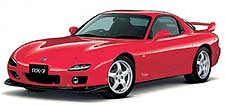In the 80’s and early 90’s some of the sports car
offerings from Japan were quite sensational. The twin turbo RX7 for
example was an exceptionally good handling and performance oriented
vehicle. Some of the Toyota Supras were also fireballs and even the
Mitsubishi 3000 GT was no slouch.
Not so long ago, the Japanese sports cars all seemed to
follow the same recipe - performance, performance, performance, regardless
of cost. That meant one-off chassis platforms, engines, suspensions,
interior modules, even steering wheels, running well past the $1 billion
mark to develop.
 Unfortunately,
the market seemed very fickle. Initial sales of the Toyota Supra, Nissan
300ZX, Mazda RX-7 and Mitsubishi 3000GT were excellent, but they soon
tapered off. After the initial period of desire, the honeymoon quickly
ended.
Unfortunately,
the market seemed very fickle. Initial sales of the Toyota Supra, Nissan
300ZX, Mazda RX-7 and Mitsubishi 3000GT were excellent, but they soon
tapered off. After the initial period of desire, the honeymoon quickly
ended.
It did not help that all four were priced above
USD35,000 when equipped with all the bells and whistles that the
enthusiasts wanted. Despite the price (or perhaps because of the price)
industry analysts projected that all four were big money losers for their
automakers.
“We learned our lessons from the last generation RX7
in terms of pricing, and in terms of the cost of the program and its
componentry,” said Jack Stavana, a former Mazda North American
Operations product planner. “We still have to capture the purity and
essence of a sports car, but compensate for the lack of utility and
function the last car had, which led us to the concept of a four-passenger
sports car for adults.”
The Japanese automakers have decided that they can no
longer afford the kudos that comes from production of these vehicles “de
novo” and have reverted to raiding the corporate parts bin for platforms
and power trains. The main reason, like most things in life, is money. It
is estimated that to build a new sports car from scratch is in the
vicinity of 1.4 billion dollars. Yes, billion. Costs are broken down as
follows - Platform: $500 million, Sheet metal: $400 million, Engine: $250
million, Powertrain: $250 million. You would certainly need to be sure you
could sell enough of the vehicle at the end of the day to cover that sort
of outlay.
Even to just give your sportycar a rocketship engine is
$250 million, so you can blow the others away at the traffic light Grands
Prix and Japan has decided it ain’t worth it. They have decided to take
the soft option and stick in an “off the shelf” engine which will be
“good enough” for all but the real hero drivers.
Here’s where the Japanese automakers will source
their bits. Nissan Motor Co. will use the 3.5 litre V6 from the mainstream
Altima and Maxima sedans for the 2003 3.5 Z car. The Z’s platform
architecture will be shared with several other Nissan branded vehicles,
details of which will be unveiled at the Tokyo Motor Show in October.
Nissan President Carlos Ghosn has demanded a car capable of 0-100 kph in
under six seconds, priced under USD30,000. And it must be profitable, he
has warned, or he’ll pull the plug, are the reports which have been
slipped to the press gallery.
Mazda Motor Corp.’s RX-8 will also be on a shared
platform. The underpinnings of the four-seat sports car also will be the
basis of the next-generation Miata, but the Miata will not get the RX8’s
rotary engine. Although four seats should increase interest from consumers
with families, Mazda also may add an even higher performance two-seat
version of the RX8 to increase volume from the platform.
Toyota Motor Corp. is considering the Lexus IS 300 rear
wheel drive platform as the basis for its successor to the Supra. With
Toyota Racing Development already building a supercharger for the Lexus’
3.0-liter inline 6 cylinder engine, Toyota could quickly borrow the
boosted engine for its sports car.
What the Japanese are doing with their sports cars is
hardly new or earth shattering. Sharing major components across model
lines has become common practice. Remember Lee Iacocca’s famous Mustang?
That was a fancy Falcon in a racy ponycar shape. Or even today, the new
Aston Martin Vanquish has switchgear from the cheaper Ford lines.
In the USA, there is a new wave of American marque
niche products such as the Ford Thunderbird and the Chevrolet SSR that are
borrowing major components from mainstream vehicles, while creating a
separate interior and exterior to market the vehicle as appearing
distinctly different.
“You borrow where it doesn’t matter to the
consumer, but it’s a fine line you don’t cross,” says one of
industry’s forecasters. Stated another way, they borrow where the
consumer doesn’t realise where it came from.
In this way, Chrysler made the Prowler for only USD200
million because it came from the corporate parts bin. What was even more
important was the fact that it didn’t look like the parts bin special!
Despite the risks inherent in the high costs of a new
car project, Mazda’s Stavana says the automaker feels it must proceed
with the RX8. “We see building the RX as a requirement and
expectation,” he said. “But of course you are faced with business
realities as well. So we’re looking at a more usable, yet true, sports
car.”